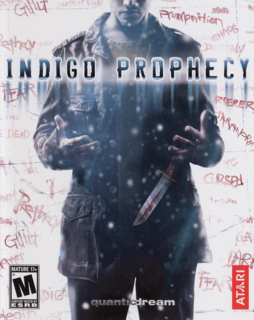As much as Indigo Prophecy is flawed, it's doubly intriguing and engrossing.
The game opens with a man, seemingly in a trance, attacking a stranger in a diner bathroom, stabbing him three times in the heart. Once this is done, the main regains consciousness, and sees the bloodshed that he has been a part of, and has to scramble to deal with this. From here, you will be given several different choices about how to deal with the dead body. Later, you will proceed to investigate the murder as two cops assigned to the case, and the actions that you took earlier will directly affect how much evidence the cops can glean from the crime scene.
The plot progresses from here, but the most impressive thing about it is how the linear story is structured to make you feel like you're making real choices. Yes, there are certain scenes where you can make a choice that dramatically alters the story in some sense, but for the most part, the story is linear from beginning to end. However, by integrating a psychological meter, something that rises and falls based on encouraging or discouraging actions/experiences, every small action you take has some weight to it, so you'll be constantly searching for ways to do things that increase your mental aptitude, which makes the story feel less linear than it actually is. It also helps that many of the actions you take are entirely optional, and do have perceivable impact later in the story. Despite the fact that regardless of how you play, you'll still end up at that final scene, there's enough ways to change the circumstances of the story that you feel like you're really having an effect. Structurally, Indigo Prophecy solves the riddle of how to manage linear storytelling in a non-linear medium. It also helps that the interface for manipulating objects is simple, even if moving your characters about is a little wonky.
The other neat aspect of Indigo Prophecy is how conversations work. Instead of giving you unlimited time in which to choose your next response, you are given a time-limit, and the choice of several possible responses, defined by a single word or phrase, which you must select before time runs out. It's a quick and intuitive way of guiding the conversations, and it doesn't give away what exactly is being said, making it a step up from most other graphic adventure game dialogue trees. The one annoyance is that you can't, like in many other adventure games, choose every single dialogue option that's presented to you; you're typically limited to selecting one or two out of three or four. This makes sense in some contexts, like answering a character's question, but for instance, if a cop has four questions pertaining to a murder, why would he or she only ask two of them? It's presumably to give some weight to the choices you make, but it's not integrated with enough restraint.
When you're not solving puzzles or talking to people, chances are you're interacting with the game's Quick-Time Event system, which is by far the worst aspect of the game. It's not that pressing the analogue sticks in specific directions quickly (to correspond with the pattern displayed on-screen) is always awkward; there are moments in the game where it kind of makes sense. And whenever possible, the game tries to make the motions you make on the analogue sticks relevant to the movement your character makes. But the fact of the matter is that playing Simon Says while watching a cut-scene does not count as terribly interactive. It also interferes with your ability to actually watch the cut-scene, which makes the sequences less visceral. It's apparent that Indigo Prophecy's developers were simultaneously out of ideas as to how to make certain aspects of the storytelling interactive and unwilling to use simple cut-scenes, but the solution they arrived at turns out to be worse than simply giving in and using more pure cut-scenes.
Many of these flaws are easier to tolerate thanks to the fairly strong story driving Indigo Prophecy. Through the first two thirds, it's a thrilling and intriguing supernatural mystery, full of interesting characters, good writing and strong acting. You come to care a lot about the protagonist, his brother, the cops investigating the murder, and the other characters you meet along the way, creating a tale that's absorbing, and constantly pushing you to see the next sequence. It falls apart a bit, however, towards the last act. It's not that the plot suddenly becomes poor, but it feels a good deal rushed, as if the writer, finally having the ending in sight, rushed through the bare minimum of plot he needed to get to the final encounter. Some important character development and exposition on some of the revealed factions is missing. This doesn't ruin the story, however, just make it less than it could have been.
Like with most experiments, Indigo Prophecy has to be taken as a whole rather than nitpicked for every little flaw. Yes, some of the storytelling techniques are a little badly implemented, and the story lacks some density towards the end, but it does more right than it does wrong. For anyone who enjoys graphic adventure games, is interested interactive storytelling or just wants a good tale, Indigo Propehcy is a strong title.

